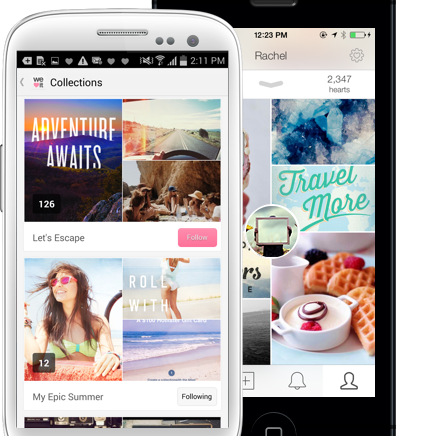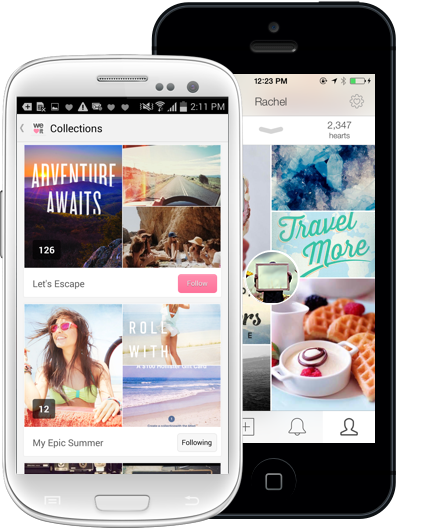We Heart It is one of those companies that just gives you good vibes. From their clean UI, stunning photos, to their platform of sharing, there’s so much to like.
At its core, We Heart It is a community of people who love beautiful photography. It started as a website in Brazil in 2010 and has grown quickly since then — launching iOS and Android apps back in 2013 which experienced some of the fastest mobile growth on the market. Today 80-90% of the platform’s traffic is mobile.
So what’s the secret to their growth? I sat down with We Heart It’s Product Manager, Tyler Coffey, to ask him just that.
What drives organic growth?
Two things: a fundamentally positive experience and word of mouth. We Heart It grew out of a simple idea – how can we organize and better share photos? Beyond this, how can we do it for the people that actually care about it most? We Heart It found that focusing on delivering a positive experience for their users from start to finish, they were able to build a product that their target audience really fell in love with.
This passion for their product drove the well-known growth ingredient for success, word of mouth. As Tyler noted, “People who enjoy the experience enough to tell their friends are the people you need to cater towards.” They will be the ones that will ultimately grow your app.
Does sharing really matter?
So you’ve built a great product and people want to share it. What now? Tyler recommends making it as easy as possible using native features inside the app — like the iOS share sheet. The We Heart It team learned that email sharing just didn’t work, and so they looked at how people in their demographic used sharing share and found that there were lots of methods to chose from. By localizing based on the device, the native share sheet can save you time and give users the experience they really want.
Before making any decision, however, it’s critical to understand how your audience shares with friends and family. It’s only worth building a sharing tool option by hand if you know the value it will provide.
Beyond how people share, you also have to consider when to ask users to share. Tyler mentioned that you need to, “Share where people expect it, and make it contextual.” This idea of contextual sharing is incredibly important. For example, they serve up notifications to share after their users have spent time and energy creating something they are very proud of — like a photo album or piece of content. That’s when they choose to place the sharing call-to-action.
While you consider when to prompt your users, also consider the language. Don’t underestimate the wording on native sharing and prompts. The call-to-action not only has to be well timed, it has to make sense and be something the user will connect with. Communicate the value to the user in your wording, and if you’re an engineer, consider hiring somebody who can help you achieve this.
What should be your priority as an app developer?
One success Tyler shared from his adventures at We Heart It was the implementation of a messaging feature called Postcards. The one-to-one messaging portal allowed users to toggle between shared messages and pictures. Before development on this product even began, Tyler and his team put in an immense amount of energy and thought into one core thing — protecting their users.
Tyler mentioned this as an important point. While the objective of this new messaging feature was future app growth, their priority still remained on protecting the user. He suggests that developers should keep this as a top priority as they continually test new ways to acquire users.
How do you deal with bad reviews in the app stores?
Plainly stated, “You have to grow thick skin.” Ultimately, while they may drag on your visibility in the app store, it’s not always as bad as you may think. Often times there’s a large vocal minority. If you start worrying about bad ratings, look to see if it’s a large number of people or just a small segment of people chiming in? Every decision should be backed by data — if you don’t have quantitative tracking, use feedback and surveys to get helpful qualitative data.
What’s your favorite mobile growth tool?
Tyler suggests that if you’re starting out, it might be best to use your own data warehouse. Just make sure to have a stats counter so you can run queries against everything you’re storing.
Beyond this, when you think you’re ready to make the plunge into deeplinking, attribution, or in-app analytics, make sure to do your homework. Tyler recommends to “do some interviews, figure out how you’re trying to grow, and make sure to involve a partner in the conversation about where you are and where you want to go with their help.” More importantly, have your difficult questions ready before you enter the sales conversation. Know from the very beginning which metrics are important to you.
What’s your final advice for new app developers?
Don’t get too caught up on one feature. Have a clear understanding of your starting point and roadmap and how the feature relates back to your ultimate goal. Beyond this, it’s okay to MVP it! If you can collect data, improve, and iterate then an MVP may actually be the best way to build your product.
Interested in having your mobile app as a featured integration in our blog? Use this form to let us know how you are using Branch.
























